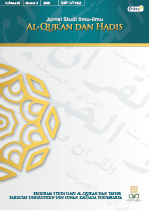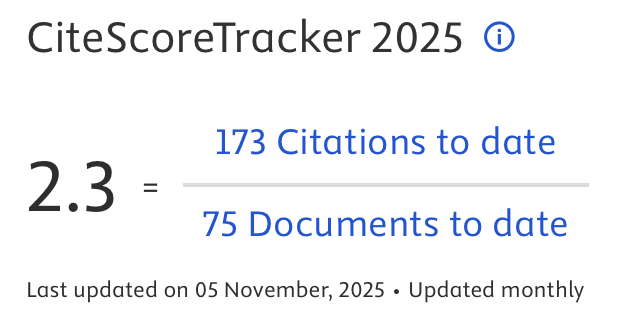Al-Tadlīl ‘alā Imāmah Abī Bakr min Khilāli Tafsīr al-Māturīdī
DOI:
https://doi.org/10.14421/qh.v23i2.3642Keywords:
Maturidi, Caliphate, Abu Bakr, Qur'anic Exegesis, Caliphate, Abu Bakar, Tafsir, Abu Mansur Al-Maturidi, ImamatAbstract
Abū Manṣūr Muḥammad b. Maḥmūd al-Samarḳandī (d. 333/944), the founder of the Māturīdiyya sect, is one of the significant scholars of the Hanafi sect. Imam Māturīdī is a scholar in the history of Islamic science who became famous for a theologian (mutaqallim), interpreter (mufassir) and jurist (faqīh), and is known for his Kitāb al-Tawḥīd. Besides that, Māturīdī and his commentary entitled Taʼwīlāt al-Qurʼān - one of the earliest tafsir bi al-ra’y (bi-al dirayah) examples of the exegetical literature- have broadly been studied in Turkish theology academia especially in recent years. This study aims to discuss the verses related to Abū Bakr’s (d. 13/634) caliphate in Imam al-Māturīdī’s Taʼwīlāt al-Qurʼān in terms of the distinction between tafsir and ta’wil. As it is known, the distinction between tafsir and ta’wil is based on Māturīdī’s writings. According to this distinction, tafsir is the process of interpretation particularly by the companions whereas ta’wil is done by the fuqaha. Therefore it is appropriate to say that tafsir means “contextual meaning” while ta’wil stands for “commentation.” As a matter of fact, Māturīdī also explains the word tafsir as the first and original meaning of the Qur’an in the context of its revelation. However, he explains in his Taʼwīlāt al-Qurʼān many verses by associating them with some issues that emerged after the revelation of the Qur’an, thus making “ta’wil.” Moreover, he gave the title Taʼwīlāt to his work in accordance with this understanding. In this study, it will be discussed whether Māturīdī’s well-known definition of tafsir contradicts or not with his commentation on the verses that he claims pointing to Abū Bakr’s caliphate and/or his superiority. The verses considered evidence for Abū Bakr’s caliphate and/or his superiority in Taʼwīlāt al-Qurʼān will be scanned and in this context, the way Māturīdī understands and interprets verses such as al-Maidah 5/54, at-Tawbah 9/40, Hūd 11/84 and al-Hadid 57/19 will be analyzed.
 Abstract viewed: 399 times
|
Abstract viewed: 399 times
|
 PDF downloaded = 173 times
PDF downloaded = 173 times
References
Abduh, Şeyh Muhammed-Reşîd Rızâ, Muhammed. Menâr Tefsiri: Tefsîru’l-Kur’âni’l-Hakîm Tefsiru’l-Menâr. Çev. Rahmi Yaran-Mehmet Erdoğan. İstanbul: Ekin Yayınları, 2011.
Ağkuş, Yusuf. “Hz. Ebû Bekir’in Hilâfetinin Kur’ân’a Dayandırılması: ‘Râzî’nin Mâide 54. Âyete Yaptığı Tefsir Özelinde’”. Çukurova Üniversitesi İlahiyat Fakültesi Dergisi 21/1 (2021).
Aydın, M. Akif. “İmâmet [Fıkıh]”. Türkiye Diyanet Vakfı İslâm Ansiklopedisi. İstanbul: TDV Yayınları, 2000.
Aydınlı, Osman. “Mu‘tezile’nin İmamet Nazariyesi: Teori ve Pratik”. Dinî Araştırmalar 3/7 (2000).
Büyük, Enes. “Mâtürîdî’nin Tefsir-Te’vîl Ayrımı ve Bunun Te’vîlât’taki Pratik Değeri Üzerine Bir İnceleme”. Cumhuriyet İlahiyat Dergisi 23/1, (2019).
Çalışkan, İsmail. “Tefsirde Mâturîdî’yi Keşfetmek: İmam Mâturîdî ve Te’vîlâtu’l-Kur’ân’ın Tefsir İlmindeki Yeri.” Milel ve Nihal: İnanç, Kültür ve Mitoloji Araştırmaları Dergisi 7/2 (2010).
Çam, Süleyman- Öngüç, Muhammed Sefa. “Mâtürîdîlikte İmâmet/Devlet Başkanlığı Anlayışı (Ebü’l-Yüsr el-Pezdevî ve Ebü’l-Muîn en-Nesefî Örneği)”. Mesned İlahiyat Araştırmaları Dergisi, 11/2 (2020).
Düzgün, Şaban Ali. “Mâtürîdî’nin Kur’an Yorum Yöntemi”. Mâtürîdî’nin Düşünce Dünyası. Ed. Şaban Ali Düzgün. Ankara: Kültür ve Turizm Bakanlığı, 2018.
Fahreddîn er-Râzî. Ebû Abdillah Muhammed b. Ömer. et-Tefsîru’l-kebîr (Mefâtîhu’l-ğayb). Beyrut: Dâru’l-Fikr, 1981.
İmam Gazâlî. el-Mustasfa: İslam Hukukunda Deliller ve Yorum Metodolojisi. Çev. Yunus Apaydın. Kayseri: Rey Yayıncılık, 1994.
Gengil, Veysel. Mâtürîdî’de Tefsirin İmkânı. İstanbul: İz Yayıncılık, 2021.
Gengil, Veysel. “Mâtürîdî’de Tefsir Te’vîl Ayrımı Meselesi”, Diyanet İlmî Dergi 55 (2019).
İbn Atiyye, Ebû Muhammed Abdülhak b. Gâlib. el-Muharrerü’l-vecîz. Nşr. er-Rehhâle el-Fârûk. Beyrut, Dâru’l-Hayr, 2007.
İbn Mâce, Ebû Abdillah Muhammed b. Yezîd. es-Sünen. Nşr. M. Fuad Abdülbâkî. Çağrı Yayınları, İstanbul 1981.
Kâfiyeci, Muhyiddin Ebû Abdillah Muhammed b. Süleymân. Kitabü’t-teysîr fi kavâʽidi ʽilmi’t-tefsîr. Nşr. İsmail Cerrahoğlu. Ankara: Ankara Üniversitesi Basımevi, 1975.
Kutlu, Sönmez. “Bilinen ve Bilinmeyen Yönleriyle İmam Mâturidî.” İmam Mâturidî ve Maturidilik. Ed. Sönmez Kutlu. Ankara: Kitâbiyât Yayınları, 2003.
Kurtubî, Ebû Abdillah Muhammed b. Ahmed. el-Câmi’ li Ahkâmi’l-Kur’ân. Nşr. Abdullah b. Abdulmuhsin et-Türkî. Beyrut: Müʾessesetü’r-Risâle, 2006.
Mâtürîdî, Ebû Mansûr. Te’vîlâtü’l-Kur’ân Tercümesi. Ed. Yusuf Şevki Yavuz. Çev. S. Kemal Sandıkçı. İstanbul: Ensar, 2020.
Mâtürîdî, Ebû Mansûr Muhammed b. Mahmûd. Te’vîlâtü’l- Ḳur’ân. nşr. Ahmed Vanlıoğlu. Müracaa: Bekir Topaloğlu. İstanbul: Mizan Yayınevi, 2005-2010.
Mukâtil b. Süleymân, Ebü’l-Hasen. Tefsîru Mukâtil b. Süleymân. Nşr. Abdullah Mahmûd eş-Şehhâte. Beyrut: Müessesetü’t-Târîhi’l-Arabî, 2002.
Müslim, Ebü’l-Hüseyn Müslim b. el-Haccâc. el-Câmiʿu’ṣ-ṣaḥîḥ. Nşr. M. Fuad Abdülbâkî. İstanbul: Çağrı Yayınları, İstanbul 1981.
Nesefî, Ebü’l-Berekât Abdullah b. Ahmed. Medârikü’t-Tenzîl ve Hakâiku’t-Te’vîl. Nşr. Yusuf Ali Bedevî. Beyrut: Dâru’l-Kelimu’t-Tayyib, 1998.
Onat, Hasan. “Şiî İmâmet Nazariyesi (Kuleynî, Kummî ve Tûsî’nin Görüşleri Çerçevesinde)”. Ankara Üniversitesi İlahiyat Fakültesi Dergisi 32, (1992).
Önen, Hacı. Taberî Tefsirinin Dirâyet Boyutu. Ankara: Araştırma, 2014.
Öztürk, Mustafa. Tefsirde Ehl-i Sünnet&Şia Polemikleri. Ankara: Ankara Okulu Yayınları, 2009.
Sâvî, Ahmed b. Muhammed. Hâşiyetü’s-Sâvî ale’l-Celâleyn. Beyrut 2006.
Suyûtî, Ebü’l-Fazl Celâlüddîn Abdurrahmân. el-İtkân fî Ulûmi’l-Kur’ân. Nşr. Mustafa Dîb el-Buğâ. Beyrut: Dâru İbn Kesîr, 2006.
Şola, Hanefi. “Şîî-İmâmî Tefsirlerde Mehdi’ye Atfedilen Ayetlerin Değerlendirilmesi”. Uluslararası Mehdilik Sempozyumu Bildirileri. Ed. Mehmet Tıraşçı vd. Sivas: CU Matbaası, 2018.
Taberî, Ebû Ca’fer Muhammed b. Cerîr. Câmiu’l-beyân an te’vîli âyi’l-Kur’ân. Nşr. Abdullah b. Abdulmuhsin et-Türkî. Kahire: Dâru Hecr, 2001.
Tabersî, Ebû Alî Emînüddîn (Emînü’l-İslâm) el-Fazl. Mecma‘u’l-beyân fî tefsîru’l- Kur’ân. Beyrut: Dâru’l-Murtazâ, 2006.
Tûsî, Ebû Ca‘fer Muhammed b. Hasen. et-Tibyân fî tefsîri’l-Kur’ân. Nşr. Ahmed Habîb Kasîr el-Âmilî. Beyrut: Dâru İhyâi’t-Türâsi’l-Arabî, ts.
Uzun, Nihat. Hicrî II. Asırda Siyâset-Tefsir İlişkisi. İstanbul: Pınar Yayınları, 2011.
Ünsal, Hadiye. Erken Dönem Mekkî Surelerin Tahlili. Ankara: Ankara Okulu Yayınları, 2015.
Ünsal, Hadiye. “Tefsir Disiplininin İlk Evreleri”. İslami İlimlerin Doğuşu ve İlk Tartışmalar. Ed. Metin Özdemir-Mahmut Samar. Ankara: Fecr Yayınları, 2020.
Vâhidî, Ebü’l-Hasen Ali b. Ahmed. Esbâbü’n-Nüzûl. Riyad: Dâru’l-Meymân, 2005.
Yaşaroğlu, M. Kâmil. “Mâide Sûresi”. Türkiye Diyanet Vakfı İslâm Ansiklopedisi. Ankara: TDV Yayınları, 2003.
Yavuz, Yusuf Şevki. “Te’vil”. Türkiye Diyanet Vakfı İslâm Ansiklopedisi. İstanbul: TDV Yayınları, 2012.
Yüksel, Emrullah. “el-İbâne”. Türkiye Diyanet Vakfı İslâm Ansiklopedisi. İstanbul: TDV Yayınları, 1999.
Yüksek, Muhammed İsa. “Tefsir Metodolojisinde Anlam Yorum Ayrımının Temelleri”. Cumhuriyet İlahiyat Dergisi 22/1 (2018).
Downloads
Published
How to Cite
Issue
Section
License
Copyright (c) 2022 Hadiye Ünsal

This work is licensed under a Creative Commons Attribution-NonCommercial-NoDerivatives 4.0 International License.
Publishing your paper with Jurnal Studi Ilmu-ilmu al-Qur'an dan Hadis means that the author or authors retain the copyright in the paper. Jurnal Studi Ilmu-ilmu al-Qur'an dan Hadis uses license CC-BY-NC-ND or an equivalent license as the optimal license for the publication, distribution, use, and reuse of scholarly works. This license permits anyone to copy and redistribute the material in any medium or format and must give appropriate credit, provide a link to the license, and indicate if changes were made. If you remix, translate, transform or build upon the material you may use it for private use only and not for distribution. Jurnal Studi Ilmu-ilmu al-Qur'an dan Hadis granted an exclusive non-commercial reuse license by the author(s), but the author(s) are able to put the paper onto a website, distribute it to colleagues, give it to students, use it in your thesis, etc, so long as the use is not directed at a commercial advantage or toward private monetary gain. The author(s) can reuse the figures and tables and other information contained in their paper published by Jurnal Studi Ilmu-ilmu al-Qur'an dan Hadis in future papers or work without having to ask anyone for permission, provided that the figures, tables, or other information that is included in the new paper or work properly references the published paper as the source of the figures, tables or other information, and the new paper or work is not direct at a private monetary gain or commercial advantage.
Jurnal Studi Ilmu-ilmu al-Qur'an dan Hadis journal Open Acces articles are distrubuted under the Creative Commons Attribution-NonCommercial-NoDerivatives 4.0 International (CC BY-NC-ND 4.0). Article can be read, copy and redistribute the material ini any medium or format under the following conditions:
Attribution — You must give appropriate credit, provide a link to the license, and indicate if changes were made. You may do so in any reasonable manner, but not in any way that suggests the licensor endorses you or your use.
NonCommercial — You may not use the material for commercial purposes.
NoDerivatives — If you remix, transform, or build upon the material, you may not distribute the modified material.










